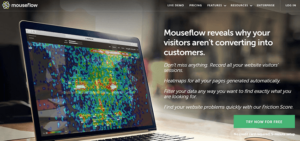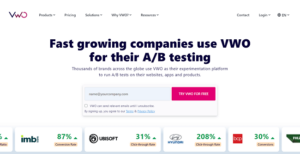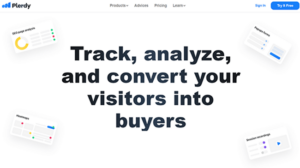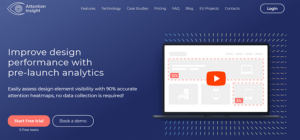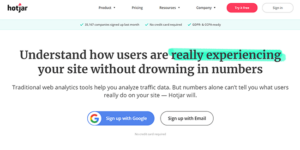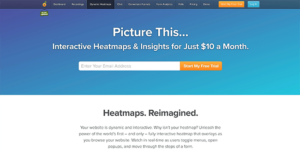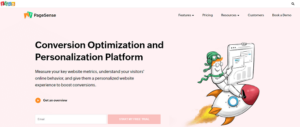This post will explain heatmap software tools. When it comes to improving your site for conversions and user experience, web traffic analysis is crucial. Heatmaps are a fantastic tool for determining which areas of your website are well-liked by visitors and which areas want development.
I’ll be reviewing the top heatmap software tools in this post to make it easier for you to produce thorough heatmaps of your web pages and make sure they are all operating as efficiently as they possibly can.
1. Mouseflow
A software toolkit called Mouseflow might assist you learn more about why customers aren’t buying from your website. You may make click, scroll, attention, geographic, and movement maps with the Mouseflow heatmap software application to effectively guide your UX and marketing decisions. Also check condo management software.
Using Mouseflow, you can monitor visitor sessions even more closely with the session replay tool in addition to the heatmap software tool.
It basically functions as CCTV for your website, allowing you to replay every action users do while browsing it. Mouseflow can also be used to track feedback campaigns, form analytics, and conversion funnels. All business sizes can use Mouseflow, which offers programmes ranging from Free to Enterprise.
2. VWO
In extra to being one of the top heatmap tools available, VWO is a potent experimentation platform that’s perfect for A/B testing. It supports a wide range of heatmap types, including dynamic heatmaps, clickmaps, and scrollmaps for every page on your site. This is another heatmap software tools.
Clickmaps can assist you find your “action points” by providing you with real-time data on where people are clicking on your website.
Even better, you can choose various locations on the website to compare the number of clicks made on each one and obtain click information for each element ID on the page.
With this information in hand, you can then include it into your website experimentation.
For instance, if you are aware that a particular location of the page typically receives more clicks, you may create a new page variation and move your action buttons there before launching an A/B testing campaign to see whether it actually does receive more clicks.
With integrated heatmaps, session recordings, and thorough analytics for all of your user segments, you can further evaluate the outcomes.
3. Plerdy
A useful heatmap tool is part of the Plerdy toolset for conversion rate optimization. You may monitor clicks, mouse movements, and scroll data from any of your pages with the heatmap tool. To improve the layout of your web pages, you may also track your users’ click paths using the Plerdy heatmap tool.
Plerdy offers a heatmap tool in addition to an SEO checker, a conversion funnel analysis tool, pop-up form software, and other features. The amazing thing about Plerdy is that you can view up to 3 heatmaps per day using the free version of the software.
This is the solution for you if you run a tiny website and want to optimise it without paying a lot of money on an expensive heatmap tool.
4. Attention Insight
The heatmap software application Attention Insight is intended to assist website owners and designers in optimising their web designs and layouts. The software allows you to construct AI-powered attention heatmaps for pages on your site as well as delivering attention percentage scores for critical buttons such as CTA buttons.
This is another heatmap software tools. You can use Attention Insight to build heatmaps of videos, which is ideal for monitoring interactions with video elements on your site or in advertisements, in addition to creating heatmaps to track the performance of particular pages.
In addition to all of this, your website will receive a clarity score that will indicate how user-friendly it is for new visitors. By examining competition designs in your niche, the score is produced.
For UX designers that need to give heatmaps to clients, the Attention Insight Team plan also enables you to develop heatmaps without using the Attention Insight brand.
5. Visitor Analytics
Create heatmaps for each of your web pages fast and effortlessly using Visitor Analytics, an all-in-one analytics tool. The programme allows you to quickly map clicks, taps, scrolling, and mouse movements. Also check donation software
As you can set up heatmap tracking for a group of pages that all have a similar layout at once, the Visitor Analytics heatmap software application is also highly helpful for sites with a number of similar pages, such as product pages.
Visitor Analytics is an excellent choice if you’re searching for an all-in-one tool for site analytics because it includes a variety of online statistic features in addition to the user behaviour features like heatmap creation and session recording.
6. Hotjar
Hotjar, in contrast to many of the tools on this list, is entirely dedicated to producing heatmaps and examining user behaviour on your website. You can create click, move, and scroll heatmaps using Hotjar, and you have the ability to divide the heatmaps by device.
You can share any heatmaps you produce with your team or clients by downloading them first. In-depth visitor recordings that Hotjar offers in addition to its heatmap tracking technology can assist you understand your users’ experiences and choices.
Hotjar also has survey and feedback tools that might assist you figure out why some aspects of your website aren’t functioning properly.
7. Clicky
One of the most well-liked real-time online analytics tools available is Clicky, and site designers and marketers love it for its heatmap monitoring functionality. The beautiful thing about Clicky’s heatmap tool is that it enables you to categorise your clicks based on particular criteria, like users who achieved a particular objective. This is another heatmap software tools.
This will allow you to distinguish between the behaviour of people who were successfully converted and those who weren’t, which is quite useful when optimising conversions.
In conclusion, Clicky is a fantastic piece of equipment for anyone who wants to truly get into heatmap analysis.
8. Lucky Orange
Lucky Orange is an excellent piece of software for anyone who is serious about staying current on conversion improvement. As a “all-in-one conversion optimization suite,” Lucky Orange describes itself as having a strong dynamic heatmap tool for tracking clicks, scroll depth, and movement.
The tool lets you monitor your user experience in real-time by superimposing heatmaps on top of your browser. To evaluate various site designs, you can also use it to segment various device kinds and alter date periods.
Along with these functions, Lucky Orange has tools that enable you to communicate with consumers, capture sessions, monitor your conversion funnels, and more.
In order to master conversion rate optimization, Lucky Orange is the ideal tool.
9. Zoho PageSense
This is another heatmap software tools. A comprehensive platform for personalisation and conversion optimization is Zoho PageSense. It offers all the tools you require, including a potent integrated heatmapping tool, to monitor, evaluate, and optimise your website for conversions. The heatmap tools allow you to see which parts of your website’s pages are receiving the most interest from users.
The session records and playback replays of how visitors engaged with your site in real-time can be useful if you want to delve a little deeper. In addition to heatmaps, PageSense enables you to monitor all of your important performance indicators. Also check Geographic Information System
You may create conversion funnels and add goals to see which of your pages clients are leaving.
Once you keep all this information, you can use it to test the effects of your modifications by running A/B campaigns and experimenting with various page layouts.
Additionally, you may run online polls and surveys, customise user experiences on your website, and do a lot more.
10. Crazy Egg
A heatmapping programme called Crazy Egg promises to “improve your site…instantly.” Agencies, e-commerce, and lead generation are just a few of the business options provided by Crazy Egg. Each solution provides a range of essential analytics tools such as exportable heatmaps and audience demographics reports.
It also contains a valuable scroll mapping tool that can help you study how users browse around your site using the scroll bar.
This type of information might be helpful in selecting where on your website to place critical CTA’s and buttons.
In addition to heat mapping and scroll mapping, you can also use Crazy egg to make website heatmap session records to see how users utilise the site on each unique visit.
The application also provides UX/UI audit options, site launch choices, and more.
11. Inspectlet
Inspectlet is a sophisticated journey tracking tool that may assist you to identify exactly what your clients visit your website for. This is another heatmap software tools.
It provides a number of tools that can assist you to develop a complete picture of how users engage with your site. Firstly, it enables dynamic heatmapping that can be used to locate activity hotspots on your web pages.
In addition to this, you can use the session recording tool to record visitor trips from beginning to end to see exactly what they’re getting up to. Inspectlet also supports A/B testing, which makes it easy to evaluate your site design and optimise your pages for conversion.
This is the great solution for analytics fans that want to develop an in-depth picture of how their site is used by visitors.
Heatmap software FAQ’s
New to utilising heatmaps?
These heatmap FAQs should help you get to grips with the basics of how you can utilise heatmaps to optimise your website.
What is heatmap tracking?
Heatmap tracking is a sort of data analysis that will assist you to gain a better sense of how users interact with your site.
Values are represented by colours instead of numbers and this makes it easier to grasp and analyse more complex data sets.
What does a heatmap show?
Heatmaps are used to show which portions of your websites are the most popular with visitors.
Depending on the sort of heatmap you build, you’ll be able to utilise it to evaluate how users click, scroll, and move their mouse whilst on your website.
How does a heatmap work?
Heatmaps show you exactly how users are interacting with your site using a colour scale. Popular regions of your site, known as hotspots, will display in hot hues like reds and oranges.
Less popular portions of the page will appear in chilly colours blues and greens.
How do I make a heatmap of my website?
To build a heatmap, you’ll need to utilise a heatmap software programme like the ones given above (e.g. Plerdy or Attention Insight) (e.g. Plerdy or Attention Insight).
All you have to do is choose what type of activities you’d like to analyse (scrolling, clicking, mouse movement) and choose the sites for which you’d like to produce a map. Then input this information into your software application to make the map.


